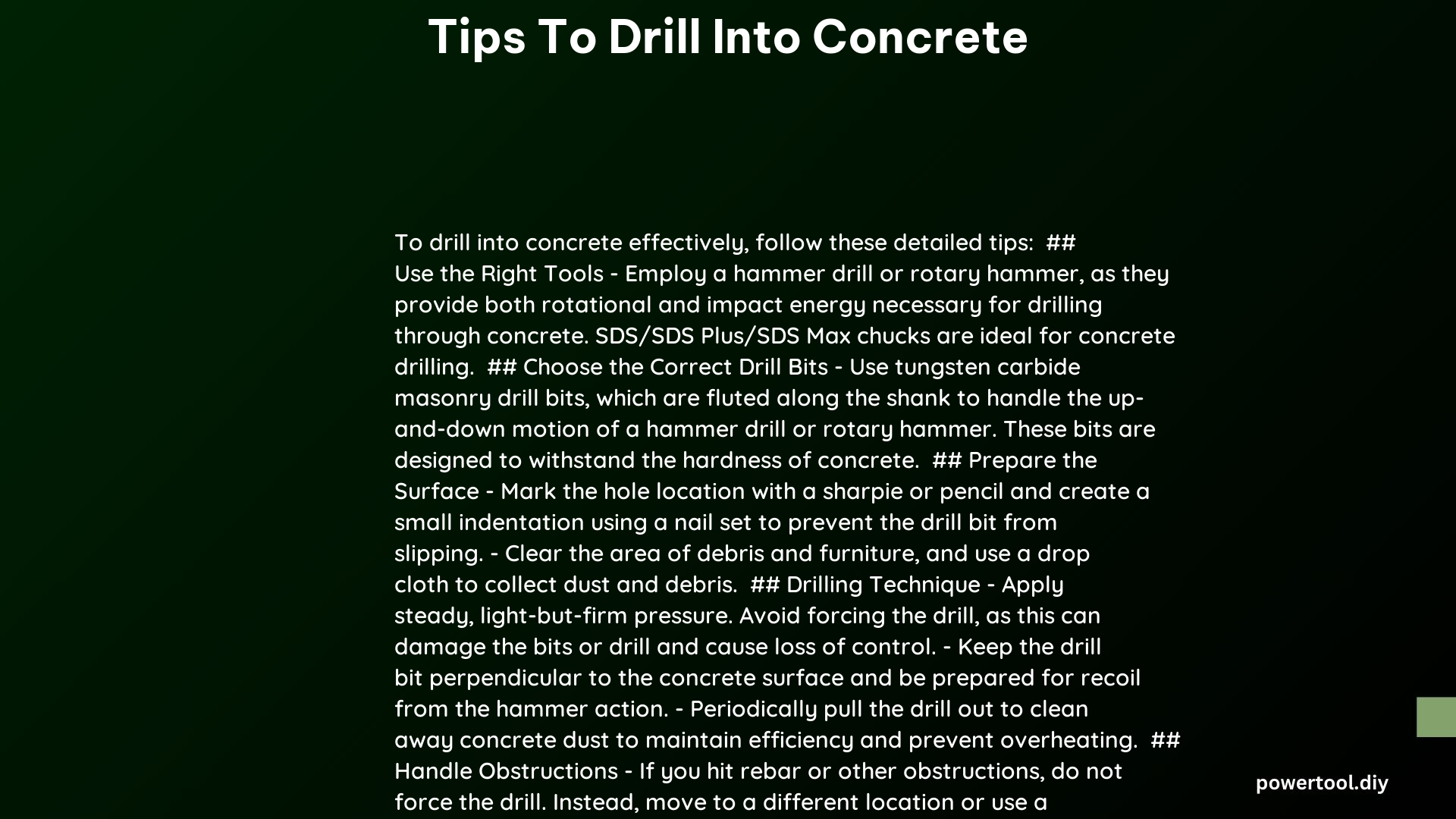Drilling into concrete requires the right tools, techniques, and safety precautions. This guide provides essential tips for successful concrete drilling, including selecting the appropriate drill and bits, maintaining proper technique, and ensuring safety. Whether you’re a DIY enthusiast or a professional, these tips will help you tackle concrete drilling projects effectively and safely.
What Equipment Do You Need for Drilling Concrete?
Drill Selection
- Hammer Drill: Essential for concrete drilling
- Types:
- Normal chuck
- SDS (Slotted Drive System) chuck (preferred)
Drill Bits
- Carbide-Tipped Bits
- Most common and effective
- Available in sizes 1/4″ to 1″ diameter
- Diamond Bits
- For specialized tasks and harder concrete
- More expensive but superior performance
Safety Gear
- ANSI-Approved Safety Goggles
- Hearing Protection (85 dB or higher rating)
- Heavy-Duty Gloves
- Dust Mask
How Do You Prepare for Concrete Drilling?

- Mark the Drilling Spot
- Use chalk or marker
-
Consider using a ChalkShot for precision
-
Check for Rebar
- Be aware of reinforced concrete
- Avoid drilling where rebar is present if possible
What Are the Best Techniques for Drilling Concrete?
- Start Gently
- Begin with light pressure
-
Increase speed once bit is engaged
-
Maintain Consistent Pressure
- Apply light to moderate force
-
Let the drill do the work
-
Keep Drill Perpendicular
- Maintain 90-degree angle to surface
- Prevents wandering and oblong holes
How Do You Cool the Drill Bit During Concrete Drilling?
| Cooling Method | Description | Recommendation |
|---|---|---|
| Water Cooling | Pouring water into hole | Not recommended (can damage bit) |
| Natural Cooling | Allow bit to cool between sessions | Preferred method |
| Minimal Water (Core Drill) | Use just enough to create slurry | Use sparingly if necessary |
What Are the Ideal Drill Settings for Concrete?
- RPM: 500 to 1,200 RPM
- Hammering Frequency: Look for high frequency (e.g., 4600 impacts/minute)
How Do You Choose the Right Bit for Concrete Density?
- Match Bit to Concrete Density
- Carbide-tipped bits are versatile
-
May need frequent replacement for hard concrete
-
Rebar Considerations
- Use rebar cutter bit if encountered
- Consider drilling around rebar
What Are the Best Practices for Drill Depth and Spacing?
Depth Control
- Use PVC tape on drill bit to mark desired depth
- Stop drilling when tape touches wall
Spacing
- Maintain appropriate distance between holes
- Preserves concrete integrity
What Additional Tips Can Improve Concrete Drilling?
- Power Source
- Corded drills generally more powerful
-
Recommended for commercial-grade concrete
-
Specialized Equipment
- Consider renting for large or complex tasks
-
Options: Core drill, rotary hammer drill
-
Bit Maintenance
- Clean bits after use
-
Replace worn or damaged bits promptly
-
Practice on Scrap
- Test techniques on spare concrete pieces
-
Helps refine skills before main project
-
Dust Management
- Use dust extraction systems when available
-
Improves visibility and reduces cleanup
-
Temperature Considerations
- Avoid drilling in extreme temperatures
-
Can affect concrete and equipment performance
-
Lubrication
- Use appropriate lubricants for bit and concrete type
- Enhances drilling efficiency and bit longevity
By following these tips, you can ensure more effective, safe, and efficient concrete drilling. Remember to always prioritize safety and use the appropriate tools for each specific task.
References:
1. YouTube: Drill Into Concrete 101 – Beginners Must Know
2. Reddit: Tips for drilling in concrete? Is this concrete just too hard?
3. Bunnings Workshop: What are your tips for drilling into concrete?
